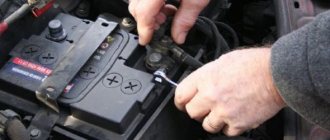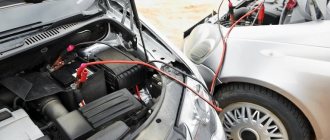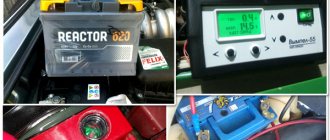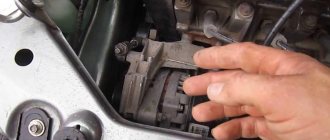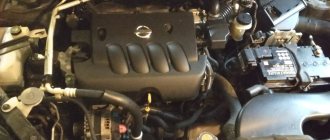The battery is literally the heart of the car. It is he who starts the engine and also ensures the operation of electrical appliances when the engine is turned off. The battery life is short - on average it is three years, but some battery models begin to lose their properties only after five years of operation. But an inexpensive, maintenance-free battery can fail after just one deep discharge. Therefore, it is important to know the basic rules of battery care and, of course, do not forget to regularly perform simple manipulations.
Types and differences in care
The battery life directly depends on how well it is cared for. This device supplies other systems with electrical energy, thanks to which the car can move.
There are two types of batteries: maintenance-free and maintenance-free.
The first type is the most common; it really does not require maintenance for 5–7 years. According to the manufacturer, there is no need to check the density, add electrolyte or check the charge.
Maintenance-free batteries are easier to use. I set them and forgot about them for 7 years. After which I replaced it with a new one. It's more expensive, but you don't have to bother with cleaning and washing.
Serviced devices require regular maintenance. With proper maintenance, they can be used for a long time. Such batteries are gradually leaving the automotive market, but many still continue to use them.
Batteries can be divided into two types:
Serviced
These are batteries in which special plugs are installed, by unscrewing which you can gain access to the battery banks. This allows you to check the density of the electrolyte, its quantity, and replace the electrolyte if necessary.
Maintenance-free
Such batteries are increasingly being produced by manufacturers and are displacing serviceable ones from the market. They do not have plugs in their body. However, it would be a big misconception to think that if a battery is called “maintenance-free”, then it does not need maintenance.
Storage
Almost all car parts require periodic inspection of their technical condition. The battery needs it the most.
If the car is not used in winter, the battery should be removed so that it survives until spring.
Preparing the battery for winter storage:
- You will need to fully charge the device first. Charging is important for it to take shape.
- Then clean the leads using sandpaper. It is important to remove the old oxide from them. After which they should be degreased and lubricated with grease.
In the spring, you just need to clean the terminals with gasoline and charge the device. Then drain the electrolyte, wash the inner walls, dry it and fill it back with electrolyte.
Car battery care is very important. It should be kept in a place that is not exposed to freezing weather. In winter, it is stored in a heated garage, basement, or brought into the house.
A fully charged battery freezes at -25 degrees, while a completely discharged battery can freeze at 0 degrees. Therefore, you should never let her sit down completely.
A frozen battery will not only fail to provide a charge, but it can potentially damage the battery compartment or internal components, which may require replacement.
Keep the battery fully charged. The vehicle requires much more battery power to start in cold weather and the battery may need to be fully charged.
Check the battery every 3-6 months. Take it to an auto parts store every six months to have it checked. This is usually a free service.
Rules for caring for a maintenance-free battery
Rechargeable batteries are divided into three types: maintenance-free, low-maintenance and maintenance-free. From the point of view of care, they differ slightly - the standard list of rules for the first two types is supplemented by the need to periodically check the electrolyte level and top it up. In addition, for serviced models, it is even possible to repair batteries, including replacing the plates. But this requires high qualifications, so first let’s look at basic care using the example of maintenance-free batteries. They require regular carrying out:
- Cleaning terminals and contact parts of power wires. Metal tends to oxidize, so it is important to prevent wires from sticking to the terminals, otherwise problems may arise when disconnecting them during an emergency. The terminals and contacts are cleaned with a metal brush with ammonia or an aqueous solution of soda. After cleaning, you should secure the contacts and lubricate the terminals with lithol, grease or other similar lubricant to prevent their re-oxidation.
- Cleaning the housing. Do not allow the battery housing to become dirty. If you have a maintenance-free battery, then special attention should be paid to cleaning the gas outlet, since contamination can lead to device failure.
- Checking the fastenings. Rigid mounting of the battery is necessary to avoid damage to the plates due to vibration and shock. Therefore, you must ensure that the clamping bars provide a good hold on the device.
Basic care rules also include periodic charging of the car battery. Under standard conditions, the battery charges the vehicle's generator, but when it is idle for a long time, as well as in winter, additional recharging of the battery is often required using a specialized charger.
To determine whether your car battery needs to be charged, there is no other way than to test the battery with a multimeter. The normal voltage at its terminals when the engine is not running should be at the level of 12.5-13 V. If it is less, then it is better to charge the battery. To do this, the battery must be removed and moved to a dry, heated room.
Any device that allows you to regulate the charging current of the car battery is suitable for charging the battery - it should be in the range from 5 to 10% of the battery capacity. In this case, it is necessary to ensure that the voltage at the terminals does not rise above 14.4 V, otherwise the battery may simply “boil”, which for maintenance-free batteries is tantamount to failure. After charging has been completed, first disconnect the charger and then the battery, starting from the negative terminal.
Electrolyte level
The electrolyte level in the battery should be checked every few months. You don't have to do this dirty work every week.
Its level should be between o and “MAX”. To restore it you need to add distilled water. Tap water cannot be used, otherwise scale will form on the walls.
If the battery is draining quickly, the electrolyte has turned brown, or the device is not producing voltage at all, it's time to clean the inside.
Flushing is not a panacea for all problems and in the near future you will have to go to a service station.
How to wash the battery and replace the electrolyte:
- First, pump out the contaminated electrolyte.
- Then pour distilled water into the system and rinse the walls. Pour out the used liquid and repeat the procedure until it comes out clean.
- Leave the last water inside for 2-3 hours. Add electrolyte to the jars, trying to maintain a density of 1.2.
- Then you should put the device on charge and leave it for a day.
That's all. The battery has been cleaned and is fully functional again.
Winter battery operation
A car that has been sitting in the cold for a long time often does not want to start the first time. And even when starting, an engine with frozen pistons and cylinders requires significantly more output from the battery than when starting conditions were not so extreme. As a result, the battery can hardly be charged. Therefore, the car owner will have to constantly maintain it in working condition, paying more attention to it.
And you should remember this not with the onset of frost, but much earlier. The reason is that if the engine is cranked for a long time (more than 15 minutes), this will cause the battery plates to melt, its energy capacity will drop, and its performance will deteriorate. To keep your battery in working condition in winter, you should do the following:
- Clean the battery case and ventilation holes from any dirt that has accumulated there over the summer;
- The oxide should be removed from the terminals and treated with lithol;
- There is no need to tighten the bolts during processing, so that if such a need arises (in the form of a short circuit), the terminals can easily open;
- Increase the charge level of the battery power supply to the standard specified by the manufacturer. If, due to the lack of special equipment or relevant experience, it is impossible to do this yourself, you should use the help of professionals.
These steps should be performed at least twice a month, and preferably more often (especially if the battery is old and barely working). If possible, it is best to leave the battery “overnight” in the house. We must not forget that the speed of all processes occurring in the battery slows down as the temperature decreases, which results in its energy intensity decreasing.
Additionally, it should be noted that in order to ensure uninterrupted operation of the battery in winter, it is necessary to use one or another thermal insulation material, thereby protecting the battery and engine compartment from frost. At the same time, throughout the winter you should increase the performance of the battery by recharging it from time to time.
In our climate, it wouldn’t hurt to buy special starter batteries that operate on lead plates. This would indeed be a wise decision, since such batteries work well even when the temperature drops well below zero.
Charger
The battery is used to start the engine and operate on-board electrical equipment. If it is discharged, the car will not move and will make characteristic sounds. She will stall.
If you have a voltmeter, check the residual capacity regularly.
The principle of charging the device is simple, even a woman can handle it.
To avoid having to travel to pick up your car battery, just take proper care of it. Clean and charge in a timely manner.
Algorithm of actions:
- Remove the battery from the car. If you are on the road and it is discharged, drive up to any house and ask for help, disconnect the negative wire.
- Then clean the terminals, even if they have recently been cleaned and lubricated.
- Don't forget to remove the plug so that the electrolyte vapor can escape freely.
- Connecting the charger is quick. You just need to connect the wires to the terminals and find where you can insert the plug.
Charging lasts about a day and allows you to replenish the battery capacity. But if you are on the road, so as not to disturb residents, leave it for a couple of hours at the nearest gas station.
How to properly care for your battery?
First of all, you will need to ensure that the battery case is clean. Avoid significant contamination of the plastic surface of the battery and pay attention to the cleanliness of the negative and positive terminals. With prolonged use, the terminals will oxidize, becoming covered with a dense layer of scale. Such scale impairs the contact of the battery with current-carrying power wires, which leads to both problems with starting the car and with gaining power while the car is moving.
If the plastic case can be wiped with a cloth soaked in water, then the terminals should be treated with ammonia and cleaned with sandpaper. Using sandpaper and ammonia, you can easily remove all oxidation products, ensuring the necessary contact of the terminal and the wires connected to it.
On maintenance-free models, be sure to clean the gas outlet. Do not allow such a valve to become contaminated. Also remember that you should not allow oil, diesel fuel, gasoline or washer fluid to come into contact with the plastic surface. If this happens, you should remove gasoline and oil from the surface of the battery as soon as possible to avoid fire.
Service options and frequency
There are serviced and maintenance-free batteries. The former need regular testing and prevention. A maintenance-free battery is not so demanding - it does not require repairs or maintenance, but it is also much more expensive.
Periodic maintenance is divided into 2 groups of procedures:
- assess the condition of the battery by external signs;
- carry out diagnostics;
- direct service.
The easiest way is to visually assess the condition of the battery. There should be no chips, cracks, leaks, or deposits on the terminals.
Deposits on battery terminals.
Then we move on to more serious questions:
- check the voltage by disconnecting the battery from the on-board network;
- evaluate battery parameters while the engine is running;
- check the level and density of the electrolyte.
There is no strict frequency of inspection. According to experienced drivers, diagnosing the battery should be done along with checking the oil level, windshield washer fluid, tire pressure, etc. That is, it should become a habit.
All these operations can be done independently, at home, and the main tools for checking are a multimeter and a load plug.
A little about discharge
I already wrote it, but I’ll say it again. DO NOT allow the battery to drain to the point of "exhaustion" when the device automatically turns off. It would be better not to allow the discharge even halfway. Therefore, if you decide to “pump” the battery of your device (as advised just above), I strongly recommend that at the end of the discharge you independently monitor and “catch” the state as close as possible to zero, but not yet 0, ideally 1%. Or at least 3%. The matter is made easier by the fact that in most devices, with standard settings, the system issues warnings at 15% of the remaining charge, then at 5% and at 3%.
And finally, the very best:
Removing and installing the battery on a car
There is nothing difficult in removing and installing the battery.
The terminals are removed, the battery is charged, and then connected, observing the polarity. You can read more about what direct battery polarity is by following the link. But it is worth noting one point. It concerns owners of fairly expensive cars with sophisticated on-board computers, security systems and additional electronics. It is somewhat more difficult to operate the battery with them. In this case, removing the battery (read de-energizing the on-board network) can lead to a malfunction of all expensive electronics. Therefore, some in this situation prefer to charge the battery directly on the car. But this is not a solution, since voltage fluctuations and surges are also harmful to on-board electronics. It is better to use a portable battery to temporarily power all vehicle systems.
Portable battery
You simply connect the crocodiles of the portable battery to the terminals, observing the polarity, and then remove them from the terminals of the standard battery. And after charging it, connect the battery in the reverse order and continue to use the battery.
Car battery life
A battery is a kind of small factory that produces and transmits electricity to a machine. It is this energy that starts the operation of the vehicle engine. Like any complex unit, a battery has its own service life. Good batteries can serve their owner for 5 and sometimes 10 years. This will depend on many factors, one of the main ones, we can confidently consider, is good battery care. What do experts refer to such care? Let's figure it out together.
